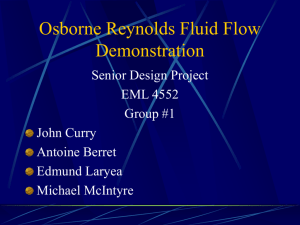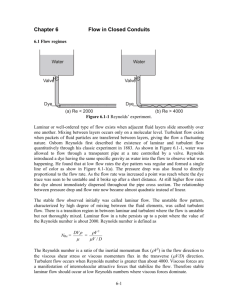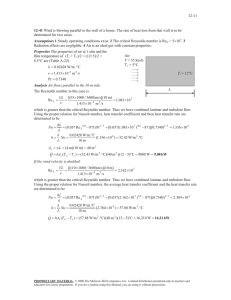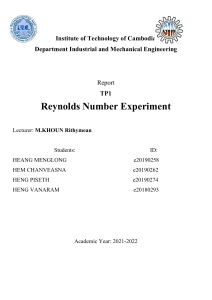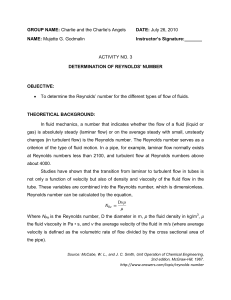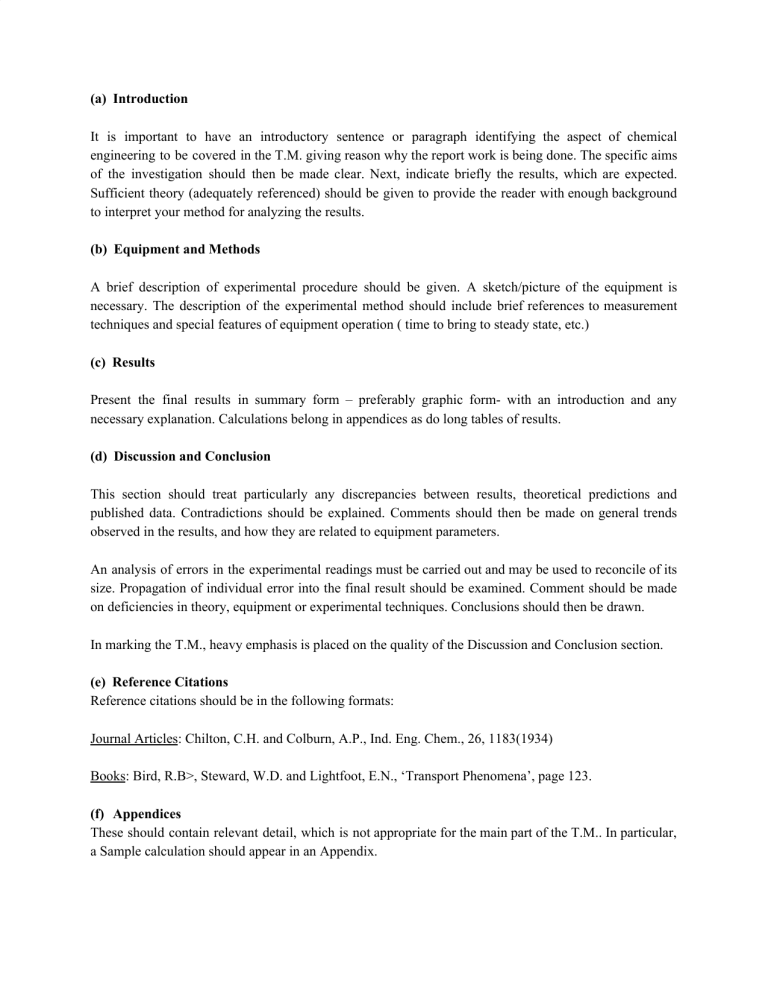
(a) I ntroduction It is important to have an introductory sentence or paragraph identifying the aspect of chemical engineering to be covered in the T.M. giving reason why the report work is being done. The specific aims of the investigation should then be made clear. Next, indicate briefly the results, which are expected. Sufficient theory (adequately referenced) should be given to provide the reader with enough background to interpret your method for analyzing the results. (b) E quipment and Methods A brief description of experimental procedure should be given. A sketch/picture of the equipment is necessary. The description of the experimental method should include brief references to measurement techniques and special features of equipment operation ( time to bring to steady state, etc.) (c) R esults Present the final results in summary form – preferably graphic form- with an introduction and any necessary explanation. Calculations belong in appendices as do long tables of results. (d) D iscussion and Conclusion This section should treat particularly any discrepancies between results, theoretical predictions and published data. Contradictions should be explained. Comments should then be made on general trends observed in the results, and how they are related to equipment parameters. An analysis of errors in the experimental readings must be carried out and may be used to reconcile of its size. Propagation of individual error into the final result should be examined. Comment should be made on deficiencies in theory, equipment or experimental techniques. Conclusions should then be drawn. In marking the T.M., heavy emphasis is placed on the quality of the Discussion and Conclusion section. (e) Reference Citations Reference citations should be in the following formats: Journal Articles: Chilton, C.H. and Colburn, A.P., Ind. Eng. Chem., 26, 1183(1934) Books: Bird, R.B>, Steward, W.D. and Lightfoot, E.N., ‘Transport Phenomena’, page 123. (f) Appendices These should contain relevant detail, which is not appropriate for the main part of the T.M.. In particular, a Sample calculation should appear in an Appendix. START LAB REP HERE :-) (a) Introduction Any fluid flowing through a closed channel, such as a pipe or conduit, is observed to have either laminar or turbulent flow. At low velocities, the fluid flow is observed to have a smooth flow pattern called laminar flow. Laminar flow, also known as streamline flow, occurs when parallel layers of fluid slide by one another with no disruption between the layers. At high velocities, the fluid is observed to experience lateral mixing and disruption of layers due to the prescence of eddies or small packets of fluid particles. This is called turbulent flow. The type of flow can be indicated by a fluid’s Reynolds number. The Reynolds number is a dimensionless number that is a function of the density and viscosity of a fluid; its velocity and the pipe diameter. For a straight circular pipe, Reynolds numbers below 2100 indicate laminar flow, while Reynolds numbers above 4000 indicate turbulent flow. Between 2100 and 4000 a transition region is found where flow can either be laminar or turbulent, depending on the apparatus used, which can only be determined through experimentation. It is important to determine a fluid’s Reynolds number and subsequently its type of flow because it determines the fluid’s resistance to flow in a pipe. Turbulent flow is associated with much higher values of friction, heat transfer, and mass transfer coefficients due to a much more rapid molecular diffusion of fluid particles. By knowing the Reynolds number, we can also appropriately design or improve our pipelines to optimize pressure drop and head loss, choose the correct pump for the appropriate situation, etc. Overall, the Reynolds number is very important as it is our basis of solution for a number of chemical engineering problems. This experiment procedure is modeled after the original set-up done by Osborne Reynold in 1880s. Water flows at steady state through a transparent pipe with the flow rate controlled by a valve. A steady stream of dye is introduced from a fine jet and its flow pattern is observed. Four flow patterns are to be observed: filament, wave, section and turbulent. At low velocities, the dye will flow as a fine filament, visually appearing as slender and threadlike. As the velocity increases, the flow becomes wavy; and upon further increase, the waves will break into sections. Both flow patterns indicate transition flow, and are expected to have Reynolds numbers between 2100 and 4000. Beyond section flow, the dye will completely diffuse into the water and produce erratic and at times, barely visible flow patterns which indicate turbulent flow. (b) Equipment and Methods The equipment used in this experiment is the Osborne Reynolds Apparatus. The Osborne Reynolds Apparatus is used to study and display either laminar, transient, or turbulent flow(GUNT Gerätebau, 2019). In this experiment, the task is to show four kinds of flow namely filament, wave, section and turbulent and determine their respective Reynolds number. The four types of flow are progressing from laminar to transient to turbulent with the filament flow as our laminar flow and turbulent flow as our turbulent flow. The wave and section flow represent the transition flow. The equipment consists of a transparent pipe section where water flows, with an optimized inlet, to a tank. A valve can be used to adjust the flow rate in the pipe section. A dye is injected at the top of the pipe section, where it is also controlled by a valve, to demonstrate the type of flow when certain adjustments are made at the different valves. There is a layer of glass beads in the water tank to ensure an even and low turbulence flow so that the dye can flow smoothly through the pipe section. At the top of the tank, there is an outlet to ensure that the water level inside the tank is constant and to prevent the spilling of water when the tank is too full. At the middle of the tank is another pipe where the dye flows out. A discharge valve is used to regulate the flow rate at the outlet of the dye. The constants in the experiment are the outlet pipe diameter and the density, viscosity, and temperature of the water leaving the flowrate at the discharge end to be the remaining variable. In operating the equipment, a known quantity of water was collected in a measured time at the discharge tube to find the flow rate(OSBORNE-REYNOLDS APPARATUS, 2019), this is done for four trials for each flow. There were no specific time in collecting the discharge flow since the rate at which the measuring cylinder was filled was to be considered. Observing the flow of the dye is the indicator to determine whether the flow is laminar, wave, section or turbulent. The whole operation of the equipment relies mainly on the adjustment of the discharge valve for obtaining the desired flow. References: Privacy statement - GUNT Gerätebau. (n.d.). Retrieved July 4, 2019, from https://www.gunt.de/en/privacy-statement-footer OSBORNE-REYNOLDS APPARATUS. (n.d.). Retrieved July 4, 2019, from https://www.tecquipment.com/osborne-reynolds-apparatus (e) References Geankoplis, C., ‘Transport Processes and Unit Operations’, page 48-50 Hall, S., ‘Rules of Thumb for Chemical Engineers’, page 9 McCabe, W., Smith, J. and Harriot, P., ‘Unit Operations of Chemical Engineers’, page 52 Cengel, Y. and Cimbala J., ‘Fluid Mechanics: Fundamentals and Applications’, page 352 Falkovich, G. ‘Fluid Mechanics: A Short Course for Physicists’, page 54-58


